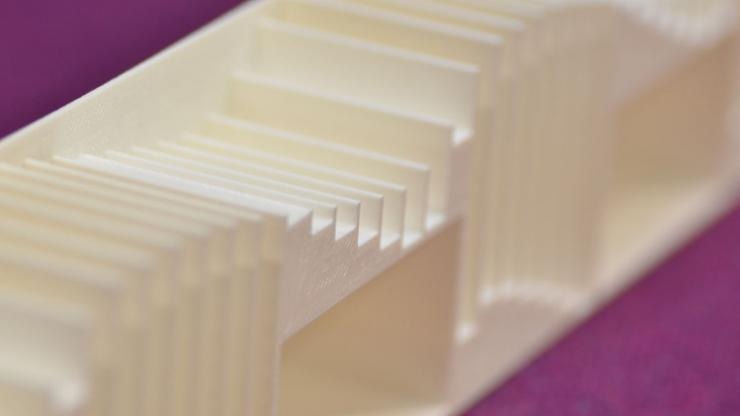Mar 8 2019
A team of scientists at Duke University and Aalto University (Finland) have designed a “meta-mirror” device that can flawlessly reflect sound waves in all directions. The proof-of-concept demonstration is similar to staring directly into a mirror and only seeing the person near you rather than one’s own face.
 This “metamaterial” controls which way sound reflects off of it by controlling the sound wave’s speed and amplitude through the channels and shapes built within it. (Image credit: Duke University)
This “metamaterial” controls which way sound reflects off of it by controlling the sound wave’s speed and amplitude through the channels and shapes built within it. (Image credit: Duke University)
The research was published online on February 15th in the journal Scientific Advances.
“When you look into an everyday mirror, the light follows the Law of Reflection: the light must bounce off of it at the same angle that it came in at,” said Junfei Li, a doctoral student in electrical and computer engineering at Duke University. The same rules usually apply to sound, but “we wanted to see if we could instead send a wave off in a different direction.”
To break the law of reflection with sound waves, the scientists had to contrive a device that could precisely exploit amplitude (loudness) and speed throughout the whole wave, which is even tougher than it sounds.
One way we could achieve this is by magically launching a precisely controlled sound wave that ‘strikes’ the incoming sound wave like balls on a pool table. But trying to do that would cause so much trouble that it’s not a practical idea.
Junfei Li, Doctoral Student In Electrical and Computer Engineering, Duke University.
Rather than resorting to magic, Li and his colleagues chose metamaterials—artificial materials that exploit waves like sound and light through their structure rather than their chemistry. For instance, while the specific metamaterial that the team engineered is composed of plastic, it is not the properties of the plastic that are significant; it is the shapes of the device’s characteristics that enable it to direct sound waves in any direction.
The metamaterial’s surface resembles a lot like a wave itself, etched with a sequence of channels of different depths. Those depths are engineered to exactly regulate the speed at which the sound wave reflects off different points of the meta-mirror. Their wave-like positioning regulates the amplitude of the sound wave.
Because a soundwave carries energy, you have to give it a kick to redirect it. But to do this perfectly, you either have to actively redistribute the energy along the surface of the meta-mirror, which isn’t feasible, or you have to cleverly choose a shape where the energy distribution ends up being the same everywhere.
Steve Cummer, Professor of Electrical and Computer Engineering, Duke University.
As a sound wave reaches the meta-mirror, it reflects off of its curved surfaces and interferes with itself. Between the depth of its channels and the meta-mirror’s shape, this interference pattern produces the sound wave reflecting in a chosen direction without any of its energy being scattered or absorbed in an unnecessary direction.
In the proof-of-concept experiment, the metamaterial device captures a sound wave moving directly toward it at 3,000 Hertz, a very high pitch not unlike to experiencing a “ringing in your ears,” and flawlessly reflects it at an angle of 70°.
While the prototype device is precisely modified to one frequency and angle of reflection, the investigators plan to pursue a dynamic device that could alter shape to reflect various frequencies in diverse directions. They also aim to work on related devices for underwater acoustics applications.
A similar device could also be developed to regulate light waves, though its characteristics would have to be designed on a much smaller scale, as light wavelengths are shorter. Such a device would not only be able to reflect light in various directions, but also split a single wave into two arbitrary directions.
“Not only did we figure out a way to design highly efficient metasurfaces, we can also adapt the design for different functionalities,” said Ana Díaz-Rubio, a postdoctoral researcher at Aalto University who headed the research on the project’s underlying theory. “These metasurfaces are a versatile platform for arbitrary control of reflection.”
This work received support from the Academy of Finland and by a Multidisciplinary University Research Initiative grant from the Office of Naval Research (N00014-13-1-0631).
Acoustic Metamaterials with Steve Cummer